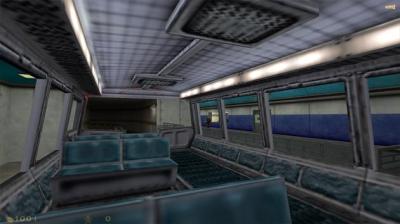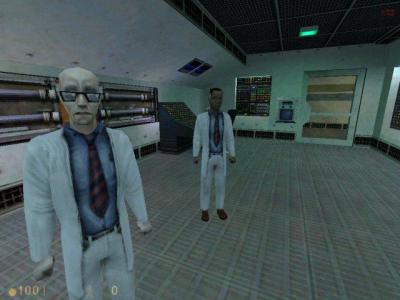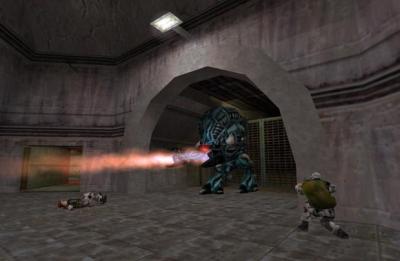Today’s post is by Jonathon Valenzuela.
———–
Title: Half-Life
Released: November 19th, 1998
I grew up a PC gamer. Though I lusted after NES and Sega as a child (my parents considered them a waste of time), we always had a decent desktop in an era when all the big innovations in games were on computers, not consoles. In 1993, I finally stopped being jealous of kids whose parents let them have ‘video games’ (the distinction between ‘video games’ and ‘computer games’ was more defined back then). The reason for this was Doom. The first true FPS* (First-person shooter) was a revelatory experience; an entirely new type of game, something I’d never seen before on my friends’ gaming systems, nor my own PC. It blew my 11-year old mind.**
See, back in the day Nintendo and Sega were considered more fun because their games were like the ones you saw in the arcades. PC games didn’t crack side scrolling until Commander Keen in late 1990. That’s a lot of button twitching fun missed out on. With PC games, you had Sierra and LucasArts calling the shots, and what their adventure games lacked in visceral, button-mashing enjoyment they made up for with excellent plots, characters and dialogue, something I came to expect from games. Doom opened the door for a genre that could offer both of these elements. Half-Life was the first game to ever successfully do it.
“Show, don’t tell” is one of the cardinal rules when crafting a narrative, and Half-Life is a perfect example of how it works when applied to gaming. In the FPS games before it, you got the story up front in a declamatory fashion (“Your base/town/alien planet is overrun with an army of demons/aliens/monsters. You’ve got to kill them all.”) before being dropped straight into the action.*** Half-Life started on a train.
This will make me sound crazy, but that is the one thing that blew my mind most about Half-Life: that opening train ride. I can remember sitting there fascinated as I wound my way into the massive underground research facility called Black Mesa, watching as scientists and security guards went about their daily business, various operational minutiae echoing from the train’s speakers. By the time my commute was finished, I was completely hooked. Never before had a game so effectively reeled me into its universe. A security guard greeted me on arrival, and made small talk while he scanned me through to the complex. Walking in, an irritated scientist complained about things running late and told me to get down to the lab immediately.
I spent 20-30 minutes just wandering around. Most of the NPCs (non-player characters) would speak to you if you interacted with them, offering pleasantries and discussing work. You could make your way to the cafeteria and blow up someone’s lunch in the microwave, causing a security guard to rush in and scold you. Rattling the stall doors in the bathroom would cause a ‘hrrrumph’. It was all so…normal, an experience not seen before in FPS, and one that really amplified the sense of inhabiting the character.
Of course, my desire to find out what happened broke the reverie and I moved on with the plot.
In Half-Life, you play Gordon Freeman, a lab technician at the aforementioned research facility who’s about to have the worst day at work ever. An experiment you participate in goes horribly wrong, tearing open portals to another dimension through which aliens begin attacking. Sounds fairly run of the mill, but it’s they way it’s told that elevates it far beyond anything that came before. As you make your way through the various complexes of Black Mesa, the story begins to unfold through scripted events and encounters with NPCs.
Panicked physicists gabble rumours about military intervention and the origin and nature of the creatures you encounter; security guards warn you of dangers ahead; slowly, the plot twists until you’re watching a scientist get gunned down by soldiers as he runs towards them to be rescued and thinking ‘holy shit, what the hell is going on?’. All the while, you’ve been having a ball blasting away at zombified Black Mesa personnel and creatures from another dimension in one of the cleanest FPS UI (user-interface) setups ever seen at the time.

Take another look at the Doom screenshot. Half-Life pioneered a HUD over a lower screen stats bar. So much more space for activities!
I’ll get back to analysis rather than listing out my favourite plot points. Half-Life was the first perfect marriage between gameplay and story for me. Rather than offering a mindless bullet-fest, every enemy vanquished brought me closer to finding out what was happening. Developers Valve threw out the antiquated system of levels and exits and replaced it with a linear progression through a series of environments divided into chapters, and chose in-game scripted sequences rather than fourth-wall-breaking cutscenes (or worse, a page of text and a loading bar) to make sure that nothing disturbed immersion in the storyline. The fact that the plot evolved at all was earth-shattering for me. It was the first game that truly felt like I was playing my way through a good science fiction comic/movie/novel (circle according to preference).
Of course, it owes a lot of that to its gameplay and UI. Navigating a 14-weapon arsenal nowadays would be an impossible maze of button pushes and pop-up menus, or, worse in my opinion, the restriction of 4 or less weapons at any time. In Half-Life (and, to be fair, almost any desktop FPS), a little practice with a scroll wheel and you could land on anything you wanted, with only a small dropdown menu appearing while the action continued. You could auto-save with the F-keys as well, so nothing broke you out of the flow of the game.
Valve and Gearbox had tweaked the Quake engine to the limits and the enemies had quite incredible A.I., enough to make some of the later fire-fights exercises in strategy rather than brute force. The variety of weapons, from stock standard fare to gluon guns and alien bee cannons, meant you could switch up your approach whenever you felt like it. The set piece battles were nicely paced, and the introduction of defeating a boss through puzzles rather than combat gave it a nice ‘brains over brawn’ feeling. Also, and I can’t say for sure if this is a fact, but I have the feeling that Half-Life was the first game where you had enemies that fought each other. That little detail**** alone makes it worth all the awards it’s won.
Half-Life set the bar incredibly high. It’s a landmark title for the genre, a game that changed the way games were designed. Valve followed it up with a couple of Rashomon-esque sequels that told the story from the perspective of a security guard and a soldier, before again pushing things forward (if only technologically) with Half-Life 2, a trilogy the final chapter of which is beginning to look like the Chinese Democracy/Detox/Second Avalanches album of the video game world.
I recently finished Bioshock Infinite and found it satisfying to see storytelling elements of the game lifted straight from the HL playbook. But Infinite is a product of a different time in gaming, one where such standards have been around for 15 years and a story-driven FPS is nothing new. Getting to play Half-Life when it first came out and experiencing that paradigm shift is something I’m thankful for as a gamer.
PS – If you’ve never played it there’s an excellent fan-made, Valve-endorsed remake called Black Mesa that’s free to download here. It’s so HD it’s ridiculous.
* Wolfenstein 3D was more proof of concept.
** Masters of Doom by David Kushner is an awesome book. History of ID software and the birth of the FPS.
*** See Doom, Quake, Shadow Warrior, Duke Nukem 3D, Rise Of The Triads, Blood, Redneck Rampage, etc etc. Although, if you do get a chance you should check out Outlaws released in 1997 by LucasArts. Great old west FPS, and the first game to introduce sniper zoom!
**** Also worth mentioning that Half-Life was the first to blend pick-ups into the environment. Finding a medkit and ammo on a shelf in a security station made a lot more sense than seeing them randomly scattered around an area, floating.
—–
Jonathon Valenzuela is a DJ, journalist and Venture Bros fan. Find his comics here and follow him on twitter.










[…] Games That Rocked…Jonathon Valenzuela’s World – #33: Half-Life (gamesthatrocked.com) […]
[…] Games That Rocked…Jonathon Valenzuela’s World – #33: Half-Life (gamesthatrocked.com) […]
By researching these online sources you can find money saving
deals for your future purchasing outings.
Additionally, if you are not really certain about making an account over
a particular site, you are free to download and here is another site for free.